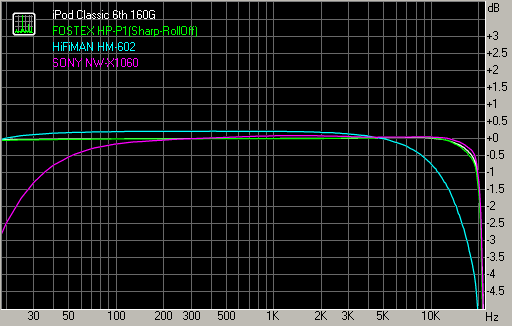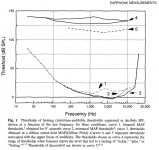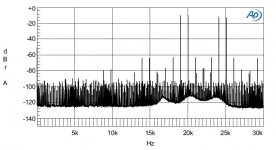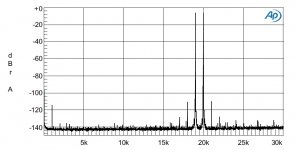A 20 megapixel camera and a 7 megapixel camera produce photos which look the same. We have a pretty good idea of the resolution which is necessary, not considering zooming in that is.
They don't look the same....by a long way.
OK, so now we have a reconstruction filter but no dither?Kastor L said:Let's just pretend the ultrasonic images and the IMD are accounted for so they are totally removed from the listening.
In that case, then you're saying I can't hear the blockiness at all, of 16-bit versus 24-bit blockiness?!
So now the filter has disappeared again? You don't seem to understand upsampling or reconstruction.I'm taking the position in that filter-less 16-bit R2R upsampled 4x via software sounds like it has more detail.
The sinusoidal and non-sinusoidal waveforms are filled in with more detail.
I suspect the thing which you have not grasped is that 16-bit 44.1kHz audio has a certain level of detail. The best we can do is to preserve that detail in the whole DAC process. Any 'detail' apparently added by some process (e.g. upsampling) is not real detail but fictitious - however much some people may prefer it. Upsampling makes analogue filter design easier, as the difficult brick-wall reconstruction filter can be partly implemented digitally. Thus upsampling may avoid reduction or distortion of detail in a necessarily compromised NOS reconstruction filter.
If the question you meant to ask is: "What bit depth is needed for end-user delivery in an undithered but otherwise well-engineered digital audio system?" then I would hazard a guess at about 17-18 bits - on the grounds that we need a few more bits to make up for the lack of dither, as a 16-bit dithered system is fine.
Humans don't hear 'bit depth'. They hear distortion. The thread title talks about 'quantisation noise' so are we talking of noise or distortion? With or without a reconstruction filter? Note that without a reconstruction filter you will be listening to ultrasonic images, which may or may not be audible and may or may not add to a perception of distortion. The 'blockiness' (in the time domain) and images (in the frequency domain) are one and the same - you did know that, didn't you?
Let's just pretend the ultrasonic images and the IMD are accounted for so they are totally removed from the listening.
In that case, then you're saying I can't hear the blockiness at all, of 16-bit versus 24-bit blockiness?!
OK, so now we have a reconstruction filter but no dither?
Yes, we have no filter and no dither.
Are you going to hazard your answer now?
Can we hear 16-bit versus 24-bit blockiness, with all the ultrasonic content and IMD removed?
I suspect the thing which you have not grasped is that 16-bit 44.1kHz audio has a certain level of detail. The best we can do is to preserve that detail in the whole DAC process. Any 'detail' apparently added by some process (e.g. upsampling) is not real detail but fictitious - however much some people may prefer it.
I understand that the detail is completely fictitious, however it is a closer approximation of reality versus it's non-existence.
Upscaling SD video to HD video is fictitious detail as well and it functions in the same respect.
Upscaling pictures and upscaling colour function in the same respect.
If the question you meant to ask is: "What bit depth is needed for end-user delivery in an undithered but otherwise well-engineered digital audio system?" then I would hazard a guess at about 17-18 bits - on the grounds that we need a few more bits to make up for the lack of dither, as a 16-bit dithered system is fine.
No, I'm not asking that.
Can we hear 16-bit versus 24-bit blockiness, with all the ultrasonic content and IMD removed?
Perhaps you can start your self-education with Fourier analysis.
OK, the filter has disappeared again.Kastor L said:Yes, we have no filter and no dither.
No, the filter has returned! (And what is this intermodulation which has appeared?)Can we hear 16-bit versus 24-bit blockiness, with all the ultrasonic content and IMD removed?
Please can you decide whether you have a reconstruction filter or not? In order to make that decision, perhaps you need to find out what a reconstruction filter does - the clue is in the name.
I can understand that filterless NOS fans may believe that the images provide a useful mimicry of reality but they are certainly not a closer approximation of reality.I understand that the detail is completely fictitious, however it is a closer approximation of reality versus it's non-existence.
Then what are you asking? We are already in a quantum-like superposition of 'filter present' and 'filter missing' (or is it 'filter missing, but all filter effects present' - a non-physical situation?). Note that our ears will serve as a poor quality reconstruction filter, augmented by the finite bandwidth of whatever transducers are being used.No, I'm not asking that.
I think you're still talking about noise, the 16-bit resolution of a sine-wave looks like this.
An externally hosted image should be here but it was not working when we last tested it.
Are you saying no one can hear that?
That ripple is 48kHz and above. Can you hear that?
Hi,
# bits SNR Possible integer values (per sample) Base ten signed range (per sample)
4 24.08 dB 16 −8 to +7
16 96.33 dB 65,536 −32,768 to +32,767
24 144.49 dB 16,777,216 −8,388,608 to +8,388,607
32 192.66 dB 4,294,967,296 −2,147,483,648 to +2,147,483,647
64 385.32 dB 18,446,744,073,709,551,616 −9,223,372,036,854,775,808 to +9,223,372,036,854,775,807
http://en.wikipedia.org/wiki/Audio_bit_depth
http://en.wikipedia.org/wiki/Signal-to-quantization-noise_ratio
A 24-bit resolution has -144.49 dB noise, due to quantization error in the ADC.
This is considered lower than the human hearing limit, thus it's estimated we can hear around 22-bit in ideal conditions.
However, that is noise.
If we remove noise from the equation, what is the highest resolution we can hear of a sine-wave, or any kind of wave?
12-bit? 32-bit? 50-bit? 100-bit? Where is the limit?
Thank you

The attached picture shows the human hearing threshold in SPL (sound pressure level).
Beyond 0 dB SPL the average human does not recognize a test tone. Above 120 dB SPL you feel discomfort.
This has nothing to do with bits or noise but with the limits of the ear.
The optical equivalent is total darkness and looking in the bright sun.
So the dynamic range of human ear is 120 dB SPL. In practise it is more like 90 dB SPL as the normal background noise in a quiet room is about 30 dB SPL.
To cover the whole human hearing range a sound reproduction system should have a lager dynamic range.
Cheers,
Udo
Attachments
What is all the low frequency stuff in the left-hand graph? Is this aliasing produced by whatever made this graph because it can't cope with the ultrasonic images? If so, that means that whatever produced this graph lacks an anti-aliasing filter.
Yes, it's a DAC without the filter.
I was too late... Jan: You mean without and with reconstruction filters 
Some background:
An ideal digital sound reproduction system does the following steps:
1.) Measure the sound pressure signal with a perfect microphone 48000 times per second.
2.) Round each measured value to the next digital bin.
N bits have 2^N bins
(e.g. 8 bins for 3 bits, 65536 bins for 16 bit)
3.) Store the samples on harddisk in a lossless digital format (e.g. wav file)
4.) Reproduce the stored sound pressure waveform with a perfect digital to analog converter
(DAC) and a perfect amplifier and loudspeakers.
A perfect DAC must have an reconstruction filter. A DAC is essentially a special lowpass filter. If you leave this filter out, your ears play the role of the
lowpass filter....
It can be shown mathematically, that the original sound pressure signal can be perfectly reproduced if it is bandlimited and if step 2 is omitted.
In an ideal digital sound reproduction system the only systematic error is the quantization process in step 2.
Fortunately the error introduced in step 2 can be made smaller than the human hearing threshold.
Udo
Some background:
An ideal digital sound reproduction system does the following steps:
1.) Measure the sound pressure signal with a perfect microphone 48000 times per second.
2.) Round each measured value to the next digital bin.
N bits have 2^N bins
(e.g. 8 bins for 3 bits, 65536 bins for 16 bit)
3.) Store the samples on harddisk in a lossless digital format (e.g. wav file)
4.) Reproduce the stored sound pressure waveform with a perfect digital to analog converter
(DAC) and a perfect amplifier and loudspeakers.
A perfect DAC must have an reconstruction filter. A DAC is essentially a special lowpass filter. If you leave this filter out, your ears play the role of the
lowpass filter....
It can be shown mathematically, that the original sound pressure signal can be perfectly reproduced if it is bandlimited and if step 2 is omitted.
In an ideal digital sound reproduction system the only systematic error is the quantization process in step 2.
Fortunately the error introduced in step 2 can be made smaller than the human hearing threshold.
Udo
My question was about the anti-aliasing filter before the ADC in whatever produced that graph. There is enough confusion in this thread already!jan.didden said:Yes, it's a DAC without the filter.
Images resulting from a poor or missing reconstruction filter are ultrasonic, starting from sampling freq/2. Your graph shows these, but also lots of low frequency crud too. The eye is naturally drawn to the LF stuff but this is irrelevant to the discussion and may confuse others.
You omitted step 0:udok said:if it is bandlimited
- band limit the acoustic signal before the perfect sampling microphone
(or use an analogue microphone and bandlimit the voltage signal)
My question was about the anti-aliasing filter before the ADC in whatever produced that graph. There is enough confusion in this thread already!
I did not produce this myself but as I understand it, a 19+20kHz sine was sampled with 44.1kHz and the resulting digital stream input to a DAC with and without reconstruction filter.
I have no info on the exact setup on the ADC side.
Jan
OK, the filter has disappeared again.
No, the filter has returned! (And what is this intermodulation which has appeared?)
Please can you decide whether you have a reconstruction filter or not? In order to make that decision, perhaps you need to find out what a reconstruction filter does - the clue is in the name.
Then what are you asking? We are already in a quantum-like superposition of 'filter present' and 'filter missing' (or is it 'filter missing, but all filter effects present' - a non-physical situation?)
You seem dizzy.
Here is where I speak of filters
post #14
"A 16-bit waveform once it has the reconstruction filter applied to it, suddenly becomes 100-bit or higher in blockiness terms."
post #16
"I've read that upsampling a 24-bit R2R provides a clear difference"
post #19
"there are various different ways to upsample
The static image equivalent is this
Image scaling - Wikipedia, the free encyclopedia
The video image equivalent is this
Toolfarm.com :: In Depth: Upscaling or Upsizing Video"
Plus
"I'm taking the position in that filter-less 16-bit R2R upsampled 4x via software sounds like it has more detail."
The filter and the dither have been missing from the question the entire time.
If you check post number #3, you'll notice the question was
"If I record reality with a 24-bit ADC, transfer that to 24-bit media like Blu-ray, then play that with a 24-bit R2R DAC, without dither and without a reconstruction filter......"
The picture I provided of the device measured at SONOVE does not have a filter.
My 16-bit R2R DAC I played around with, trying upsampling via software, does not have a filter.
Let's just change the question then
------ question ------
Let's say we are using a filterless 24-bit R2R DAC, with all the IMD and ultrasonic content filtered away.
I play a 24-bit / 48 kHz music file.
After that, I play the same file reduced to 16-bit / 48 kHz.
Will you hear any difference?
------ question ------
I can understand that filterless NOS fans may believe that the images provide a useful mimicry of reality but they are certainly not a closer approximation of reality.
O.k., so does 4xBRZ and HD video have less detail? With which reference point?
Last edited:
Let's say we are using a filterless 24-bit R2R DAC, with all the IMD and ultrasonic content filtered away.
This makes absolutely no sense. Schroedinger's Cat.
Let's say we are using a filterless 24-bit R2R DAC, with all the IMD and ultrasonic content filtered away.
What do you mean? How/where do you filter out the IM and ultrasonic stuff?
Jan
That ripple is 48kHz and above. Can you hear that?
Here is the frequency response of the device measured, no UHF content, I think?
Look at the cyan line, HM-602.
http://sonove.angry.jp/RMAA/iPodClassic6_HP-P1_HM-602_x1060.htm

OK. My guess is that an anti-aliasing filter was omitted, so the ultrasonic images from the missing reconstruction filter then produced aliases with the sampling rate of whatever produced the graph. Given the LF mess, I assume the second sampling was not at 44.1kHz or a multiple - perhaps 48kHz?jan.didden said:I did not produce this myself but as I understand it, a 19+20kHz sine was sampled with 44.1kHz and the resulting digital stream input to a DAC with and without reconstruction filter.
Your upsampling algorithm is quite likely to include a filter, whether implicitly or accidentally. In fact, the simplest upsampling algorithm (IIRC) is 'add N zero samples per original sample, then low-pass filter'.Kastor L said:My 16-bit R2R DAC I played around with, trying upsampling via software, does not have a filter.
(Underlinings added by me).Kastor L said:Let's say we are using a filterless 24-bit R2R DAC, with all the IMD and ultrasonic content filtered away.
So do we have a filter or no filter, or the non-realisable situation of the effects of the filter but no filter? Why do you persist in contradicting yourself in your question?
Please note that "sounds like it has more detail" and "has more detail" are not equivalent statements.
- Status
- This old topic is closed. If you want to reopen this topic, contact a moderator using the "Report Post" button.
- Home
- Member Areas
- The Lounge
- Highest resolution without quantization noise


